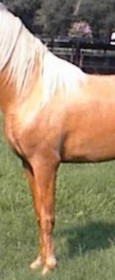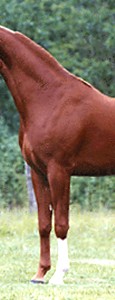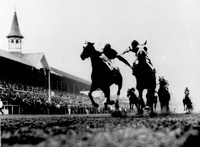An Analysis by Liz Graves
 |
 |
 |
|
|
|
|
| Understanding front-end conformation should be an important consideration in evaluating any horse before asking it to start working. The front end is important because as horse stands the front end can bear 60-65% of the horses' total body weight. While the horse is in motion, it is important that we try to help a horse distribute it's weight more evenly to all 4 four quarters of the body. We do this by engaging the hind quarters and asking the horse to carry it's self in as close to level a frame as it's structure allows. A horses' skeletal structure and muscular structure is inherited. We, as horseman, need to be aware of our horses’ strong points and their weak points and how it will effect their movement. Knowing what we can do to maintain the good points and strengthen those that may be weak and knowing an individuals limitation comes from conformation analysis. Hopefully giving us many years of good sound service from our horses.
Understanding the angles of the shoulder is extremely important, as that angle will determine the movement of the arm bone. We use 45 degrees as the ideal for basic shoulder structure. But when it comes to desiring a specific movement, a 45 degree angle may not get us the moment in the forequarters that we desire in a specific breed or gait. As a general rule we will see an upright shoulder angle give more knee action; that may be desirable in a racking horse, but certainly not in a Fox Trotter. A steeper angle can also give a rougher ride in that it is not as good a shock absorber to the front limbs. This can also make a horse raise and lift the front legs more times in the same distance than a horse with a lower angle shoulder that tends to reach out and forward more with the forelegs. A Tennessee Walking horse that does a true head shaking running walk will have a lower longer shoulder angle, while the Fox Trotter in general will more often have closer to the 45 degrees (if it is doing a true natural Fox Trot). Most often when a horse has been trimmed correctly the pastern angle will be the same or very close to the shoulder angle. Also in observing the shoulder, look at muscles. Lack of muscle or development lends the shoulder to not having the support it needs to build and maintain strength in movement. But on the flip side; a shoulder with an over abundance of muscle can also hinder the freedom of movement to the scapula as well. The importance of the arm bone (Humerus) is that it also has side to side movement not only foreword and back. This bone can determine how the elbow, knee and fetlock raise and lower and fold. The shorter the humerus the choppier the gait, the longer the humerus tends to a smoother gait being more reaching with the front legs. The lower the angle of the humerus, less the tendencies of high action of the front limbs, the steeper the angle the higher the horse can raise it's knees. When desiring a longer humerus we are looking for it to be at least 50% the length of the shoulder blade. When looking at the bones of the legs: are they set on straight? An example being a cannon bone not set straight and looking as though it has been set in the leg more towards sideways. Are the front legs set to far forward or back? Are the pasterns of the horse to long or to short? A long pastern tends to be more sloped and can stress the tendons and ligament running down the leg. A short pastern can put more stress on the front limbs tending to cause the horse to take more concussion in the front feet. Are the horse hoofs set straight or do they tend to toe in or toe out? Is the over at the knees or back at the knees? Does the horse has enough bone (circumference) to carry it's self or too heavy in bone so that it restricts a certain desired amount of action. Any deviation from Ideal can effect a nice clean, straight lift and set down of the forelimbs. When this happens with over use, lack of correct conditioning or incorrect use this opens a horse up to developing an unsoundness that effects gait and performance. Below are three pictures of front ends for evaluation. These are all side views so we will not be able to examine the width of base or how the legs bone are set on as we could from the front. Also being these are still picture we do not have the option of asking a horse to move forward, back or to stand square in front to be sure that this is truly how a horse naturally stands. So when utilizing still pictures always do so in the manner that what you see is what it is. Even though it may not be the true stance of an individual. |
Overall these horse each look to have a nice balance of bone circumference for their size. They each show a good amount of heart girth as well lending to good take in and expulsion or air to the lungs. They also look individually to be rather well balanced in the front quarters as well. Liz Graves |
Trackback URL : 이 글에는 트랙백을 보낼 수 없습니다
Trackback RSS : http://www.fallight.com/rss/trackback/1342
Trackback ATOM : http://www.fallight.com/atom/trackback/1342







